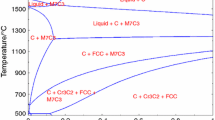Abstract
A theoretical treatment to evaluate activation energies of reactions by means of nonisothermal experiments was developed. The treatment considers the case where either the surface reaction or the intraparticle diffusion could be rate-controlling. Complementary to the theoretical treat-ment, thermogravimetric experiments have been carried out under both isothermal and noniso-thermal conditions. The reduction of MoO3 to Mo was found to pass through an intermediate MoO2 phase. The rate of reduction to MoO2 seems to be controlled by surface reaction, and the activation energy obtained from isothermal studies is 205.7 kJ/mol. This is comparable to the value of 211.6 kJ/mol obtained from nonisothermal reduction studies using the present theoretical treatment. The rate of reduction to Mo appears to be influenced by gas diffusion through voids. The activation energy from isothermal studies is 85.2 kJ/mol.
Similar content being viewed by others
References
S.J. Gentry, N.W. Hurst, and A. Jones:Chem. Soc., Faraday Trans. 1, 1979, vol. 65, pp. 1688–99.
O.J. Wimmers, P. Arnoldy, and A.J. Moulijn:J. Phys. Chem., 1986, vol. 90, pp. 1331–37.
P. Arnoldy, O.S.L. Bruinsma, and J.A. Moulijn:J. Mol. Catal., 1985, vol. 30, pp. 111–23.
P. Arnoldy, J.C.M. de Jonge, and J.A. Moulijn:J. Phys. Chem., 1985, vol. 89, pp. 4517–26.
J. Szekely, J.W. Evans, and H.Y. Sohn:Gas-Solid Reaction, Academic Press, New York, NY, 1976, pp. 642–45.
B. Phillips and L.L.Y. Chang:Trans. TMS-AIME, 1965, vol. 233, pp. 1433–36.
H. Kay and B.G. Langsten:J. Met., 1964, pp. 877-81.
C. Wassiliev, R. Nicolov, and M. Tschimbulev:Ann. Ecole Sup. Chim. Techn., 1967, vol. 13, p. 125.
G.C. Bond and J.B.P. Tripathi:J. Less-Common Met., 1974, vol. 36, pp. 31–40.
Donald T. Hawkins and Wayne L. Worrell:Metall. Trans., 1970, vol. 1, pp. 271–73.
L. Brewer and L.H. Lamoreaux:Atomic Energy Review Special Issue, No. 7,Molybdenum: Physico-chemical Properties of Its Compounds and Alloys, International Atomic Agency, Vienna, 1980, pp. 30 and 285.
O. Bertrand and L.C. Dufour:C. R. Acad. Sci. Paris, 1974, vol. 278, pp. 315–18.
J.M. Zabala, P. Grange, and B. Delmon:C. R. Acad. Sci. Paris, 1974, vol. 279, pp. 725–28.
D.M. Chizhikov, Yu. E. Ratner, and Yu. V. Tsvetkov:Russ. Metall., (Engl. Transi.), 1970, vol. 6, pp. 5–9.
J. Orchotsky and M. Kaczenski:Mater. Sci. Eng., 1979, vol. 40, pp. 245–50.
Binary Alloy Phase Diagrams, 1st ed., T.B. Massalski, ed., ASM, Metals Park, OH, 1986, p. 1613.
Author information
Authors and Affiliations
Rights and permissions
About this article
Cite this article
Sichen, D., Seetharaman, S. Application of a nonisothermal thermogravimetric method to the kinetic study of the reduction of metallic oxides: Part I. A general treatment and its application to the reduction of the oxides of molybdenum by hydrogen. Metall Trans B 23, 317–324 (1992). https://doi.org/10.1007/BF02656287
Received:
Published:
Issue Date:
DOI: https://doi.org/10.1007/BF02656287




